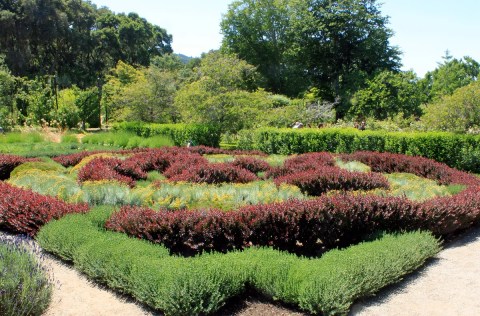Filoli
This week, soon after my visit to Blake Garden, I went to Filoli down on the peninsula. Most people interested in gardens around here seem to know it, and I’d heard a lot about it and seen a number of blogposts. Chuck B at MyBack40(feet) has done a lot of posts over the years, this being the one I remember best, TownMouse posted about a visit, and a number of other bloggers have posted about it too. But I’d never seen it in person.
Coming right after a visit to Blake, I found there was sort of an interesting contrast. Like Blake, Filoli was set up with a formal design at about the same time period, 1917 to Blake’s 1922. But unlike Blake, which has changed significantly over the years and has sort of a wild and free collection of plants, Filoli still has the formal, carefully controlled aesthetic. And while Blake feels sort of like the forgotten garden up in the hills, Filoli is still in its heyday. There were tour buses in the parking lot and more visitors than I ever see in any of the botanical gardens. It felt immaculate and beloved.
I was a little late to see some of the big floral shows like the spring bulbs, the wisterias, or the camperdown elm. This time of year, the roses and the mediterranean border are probably the highlights, plus of course the formal design. Does anyone know, is it the biggest formal garden in the Bay Area? I can’t think of a bigger one.
This is probably the most successful knot garden I’ve seen. There’s the standard view, where you can see that someone made an elaborate shape with the plants, but it’s also nice when you stand a little closer and just see the repetition of purple foliage.
The purple hedge is a southern Beech, Fagus sylvatica ‘Atropurpurea’ and I think the big tree in the background is the same. Makes me feel sad for the poor little hedged ones.
Lots of plants hedged into architecture. But also lots of great specimen trees like the oak tree towering over the garden house.
Shame on me that I had never been here before. It’s quite the garden, and I definitely want to go back some time earlier in the year when the classic spring bloomers are at their peak. This first visit just begins to scratch the surface.
This entry was posted on Sunday, June 10th, 2012 at 9:04 am and is filed under public gardens. You can follow any responses to this entry through the RSS 2.0 feed. You can leave a response, or trackback from your own site.














July 2nd, 2012 at 9:23 am
Enjoyed the tour through this garden, it really does work so well and resembles a typical European Garden, even down to the italianate style orangery in the first photo (i assume theres no need for an orangery there but it looks so similar).
The planting layouts, designs and even the plants themselves all work well to give the european estate garden look.
Fantastic 🙂
July 5th, 2012 at 10:05 pm
Interesting how the garden with he strong formal element can stay recognizable longer than a less structured one like Blake. Blame it on geometry? But I’m sure careful upkeep enters the equation as well. I’m going to be to the Bay Area later in the year and this garden looks like one that might be nice in the off season–even if the dramatic red beech is brown twigs for the winter. Still definitely one to put on the list to check out.
July 7th, 2012 at 7:18 pm
Mark and Graz: I think you’re right that they wanted an orangery but didn’t need one in this climate. Though I’m not as familiar with orangeries and some of the other classic European garden elements because I don’t see them much in California. Which is one reason that Filoli is so nice to see.
James: It is one to put on the list. Ruth Bancroft is sort of the most interesting to see in the winter with all the homemade cold frames around the tender plants, and Tilden is my favorite and really nice in the winter, but Filoli is definitely in the group to see after that and I know people who think it is the best garden in the Bay Area in the early spring.